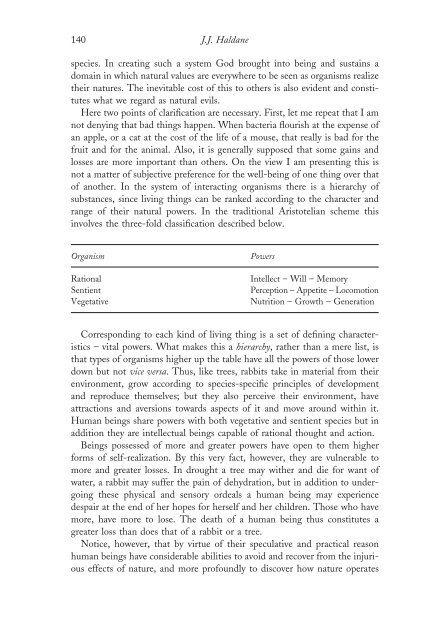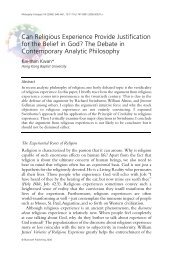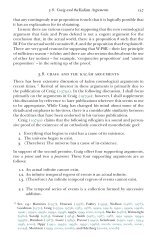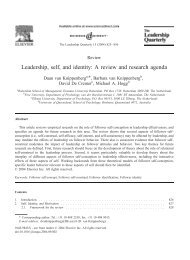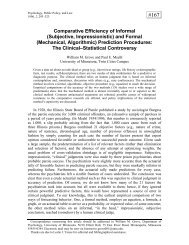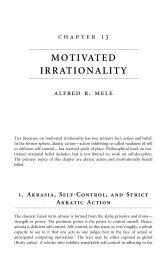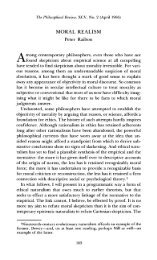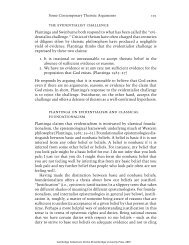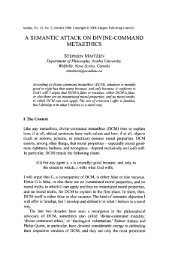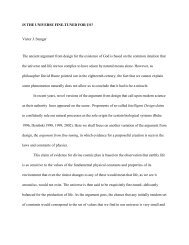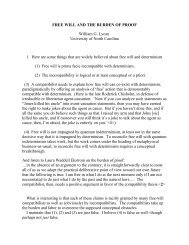Atheism and Theism JJ Haldane - Common Sense Atheism
Atheism and Theism JJ Haldane - Common Sense Atheism
Atheism and Theism JJ Haldane - Common Sense Atheism
You also want an ePaper? Increase the reach of your titles
YUMPU automatically turns print PDFs into web optimized ePapers that Google loves.
140 J.J. <strong>Haldane</strong><br />
species. In creating such a system God brought into being <strong>and</strong> sustains a<br />
domain in which natural values are everywhere to be seen as organisms realize<br />
their natures. The inevitable cost of this to others is also evident <strong>and</strong> constitutes<br />
what we regard as natural evils.<br />
Here two points of clarification are necessary. First, let me repeat that I am<br />
not denying that bad things happen. When bacteria flourish at the expense of<br />
an apple, or a cat at the cost of the life of a mouse, that really is bad for the<br />
fruit <strong>and</strong> for the animal. Also, it is generally supposed that some gains <strong>and</strong><br />
losses are more important than others. On the view I am presenting this is<br />
not a matter of subjective preference for the well-being of one thing over that<br />
of another. In the system of interacting organisms there is a hierarchy of<br />
substances, since living things can be ranked according to the character <strong>and</strong><br />
range of their natural powers. In the traditional Aristotelian scheme this<br />
involves the three-fold classification described below.<br />
Organism Powers<br />
Rational Intellect – Will – Memory<br />
Sentient Perception – Appetite – Locomotion<br />
Vegetative Nutrition – Growth – Generation<br />
Corresponding to each kind of living thing is a set of defining characteristics<br />
– vital powers. What makes this a hierarchy, rather than a mere list, is<br />
that types of organisms higher up the table have all the powers of those lower<br />
down but not vice versa. Thus, like trees, rabbits take in material from their<br />
environment, grow according to species-specific principles of development<br />
<strong>and</strong> reproduce themselves; but they also perceive their environment, have<br />
attractions <strong>and</strong> aversions towards aspects of it <strong>and</strong> move around within it.<br />
Human beings share powers with both vegetative <strong>and</strong> sentient species but in<br />
addition they are intellectual beings capable of rational thought <strong>and</strong> action.<br />
Beings possessed of more <strong>and</strong> greater powers have open to them higher<br />
forms of self-realization. By this very fact, however, they are vulnerable to<br />
more <strong>and</strong> greater losses. In drought a tree may wither <strong>and</strong> die for want of<br />
water, a rabbit may suffer the pain of dehydration, but in addition to undergoing<br />
these physical <strong>and</strong> sensory ordeals a human being may experience<br />
despair at the end of her hopes for herself <strong>and</strong> her children. Those who have<br />
more, have more to lose. The death of a human being thus constitutes a<br />
greater loss than does that of a rabbit or a tree.<br />
Notice, however, that by virtue of their speculative <strong>and</strong> practical reason<br />
human beings have considerable abilities to avoid <strong>and</strong> recover from the injurious<br />
effects of nature, <strong>and</strong> more profoundly to discover how nature operates


